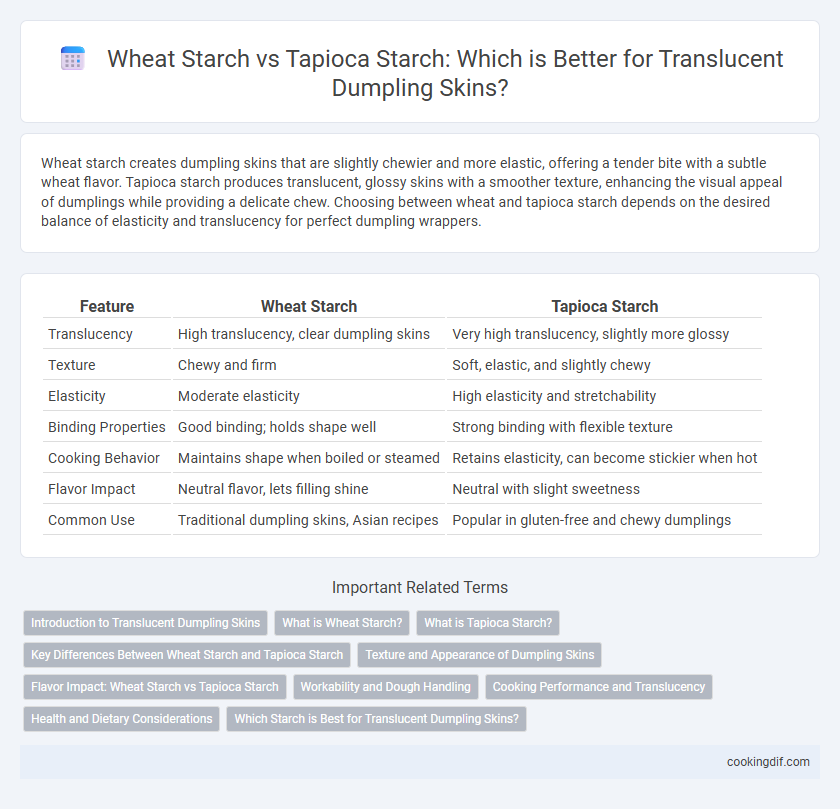Wheat starch creates dumpling skins that are slightly chewier and more elastic, offering a tender bite with a subtle wheat flavor. Tapioca starch produces translucent, glossy skins with a smoother texture, enhancing the visual appeal of dumplings while providing a delicate chew. Choosing between wheat and tapioca starch depends on the desired balance of elasticity and translucency for perfect dumpling wrappers.
Table of Comparison
| Feature | Wheat Starch | Tapioca Starch |
|---|---|---|
| Translucency | High translucency, clear dumpling skins | Very high translucency, slightly more glossy |
| Texture | Chewy and firm | Soft, elastic, and slightly chewy |
| Elasticity | Moderate elasticity | High elasticity and stretchability |
| Binding Properties | Good binding; holds shape well | Strong binding with flexible texture |
| Cooking Behavior | Maintains shape when boiled or steamed | Retains elasticity, can become stickier when hot |
| Flavor Impact | Neutral flavor, lets filling shine | Neutral with slight sweetness |
| Common Use | Traditional dumpling skins, Asian recipes | Popular in gluten-free and chewy dumplings |
Introduction to Translucent Dumpling Skins
Wheat starch and tapioca starch are two popular ingredients for achieving translucent dumpling skins, each providing a unique texture and appearance. Wheat starch produces a delicate, slightly chewy skin with a smooth surface, while tapioca starch creates a more elastic, glossy, and highly transparent wrapper. Combining these starches allows for versatile doughs that balance translucency and chewiness, essential for visually appealing and tasty dumplings.
What is Wheat Starch?
Wheat starch is a fine, white powder derived from the endosperm of wheat grains, commonly used in dumpling skins to achieve a translucent, chewy texture. It contains minimal gluten compared to whole wheat flour, making it ideal for delicate doughs that require elasticity and clarity. When combined with tapioca starch, wheat starch enhances the skin's elasticity while maintaining a glossy, translucent appearance characteristic of traditional dumplings.
What is Tapioca Starch?
Tapioca starch, derived from the cassava root, is a fine, white powder commonly used in dumpling skins to achieve a translucent and chewy texture. Unlike wheat starch, tapioca starch provides greater elasticity and a glossy appearance, making dumplings visually appealing while maintaining structural integrity during cooking. It is gluten-free and prized for its ability to create a delicate, tender skin that enhances the overall eating experience.
Key Differences Between Wheat Starch and Tapioca Starch
Wheat starch and tapioca starch differ significantly in creating translucent dumpling skins, with wheat starch offering a firmer texture and better elasticity while maintaining a slightly opaque appearance. Tapioca starch produces a more translucent, glossy skin that is softer and chewier but can be less structurally stable during cooking. The choice between wheat starch and tapioca starch impacts the dumpling's bite, transparency, and overall texture, making wheat starch ideal for sturdier skins and tapioca starch preferred for delicate, visually appealing dumplings.
Texture and Appearance of Dumpling Skins
Wheat starch yields dumpling skins with a smooth texture and clear translucency, offering a slightly chewy bite that holds shape well during steaming. Tapioca starch produces skins that are more elastic and stretchable, resulting in a glossy and highly translucent appearance but with a softer, sometimes stickier texture. Combining both starches can optimize dumpling skin elasticity and translucency, balancing chewiness and visual appeal.
Flavor Impact: Wheat Starch vs Tapioca Starch
Wheat starch produces translucent dumpling skins with a slightly chewy texture and a subtle wheat flavor that enhances savory fillings without overpowering them. Tapioca starch creates more translucent, glossy skins and lends a neutral taste that allows the dumpling's filling to stand out more prominently. Choosing between wheat and tapioca starch impacts both the flavor profile and the visual appeal of dumplings, with wheat starch offering mild grain notes and tapioca starch providing a cleaner, less intrusive taste.
Workability and Dough Handling
Wheat starch provides dough with better elasticity and strength, making it easier to roll and shape thin, translucent dumpling skins without tearing. Tapioca starch results in a more stretchy and chewy texture but can be stickier and harder to handle during dough preparation. For optimal workability and dough handling, wheat starch offers superior control and durability in creating delicate, translucent dumpling wrappers.
Cooking Performance and Translucency
Wheat starch provides dumpling skins with a firmer texture and moderate translucency, making it ideal for holding shape during boiling or steaming. Tapioca starch offers superior translucency and a chewier, stretchy texture but can become overly sticky if overcooked, requiring precise temperature control. Combining wheat and tapioca starches often enhances both structural integrity and glossy transparency in dumpling skins.
Health and Dietary Considerations
Wheat starch provides a firmer texture and contains gluten, which may not be suitable for individuals with gluten intolerance or celiac disease. Tapioca starch offers a naturally gluten-free option with a chewier, more elastic skin, making it ideal for gluten-sensitive diets. Both starches deliver low-fat, gluten-free carbohydrates but differ in allergenic potential and digestibility.
Which Starch is Best for Translucent Dumpling Skins?
Wheat starch creates a chewier, more elastic translucent dumpling skin, while tapioca starch produces a smoother, slightly more transparent texture. For dumplings requiring a delicate, glassy appearance with moderate elasticity, tapioca starch is often preferred. However, combining both starches can optimize translucency and elasticity, delivering superior dumpling skins.
Wheat starch vs Tapioca starch for translucent skins Infographic

 cookingdif.com
cookingdif.com